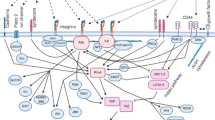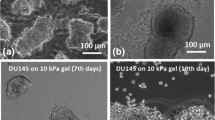Abstract
Background
Colon cancer cells can migrate and metastasize by undergoing epithelial-to-mesenchymal transition (EMT). Mesenchymal stem cells (MSCs) are non-cancerous, multipotent adult stem cells, which can also migrate. In this study, we wanted to compare the biological, physical, and functional properties of these migratory cells.
Materials and methods
HT-29 and HCT-116, two human colon carcinoma cell lines, represent less aggressive and more aggressive cancer cells, respectively. MSCs were isolated from human bone marrow. After confirming the identity of all the cell types, they were evaluated for E-cadherin, β1-integrin, Vimentin, ZEB-1, β-catenin, and 18S rRNA using Q-PCR. MMP-2 and MMP-9 activity were evaluated using gelatin zymography. Functional tests like wound healing assay, migration assay, and invasion assay were also done. Biomechanical properties like cell stiffness and non-specific adhesion (between indenter probe and cell membrane) were evaluated through nanoindentation using atomic force microscopy (AFM).
Results
Expression of EMT and stem cell markers showed typical expression patterns for HT-29, HCT-116, and MSCs. Functional tests showed that MSCs migrated faster than malignant cells. MMP-2 and MMP-9 activity reinforced this behavior. Interestingly, the migration/invasion capacity of MSCs was comparable to aggressive HCT-116, and more than HT-29. MSCs also showed the maximum cell stiffness and non-specific cell-probe adhesions, followed by HCT116 and HT29 cells.
Conclusions
Our findings indicate that the migratory properties of MSCs is comparable or even greater than that of cancer cells and despite their high migration potential, they also have the maximum stiffness.







Similar content being viewed by others
Abbreviations
- AFM:
-
Atomic force microscopy
- BSE:
-
Bottom substrate effect
- CRC:
-
Colorectal cancer
- DMEM:
-
Dulbecco’s modified Eagle’s medium
- E:
-
Elastic modulus
- EMT:
-
Epithelial-to-mesenchymal transition
- ECM:
-
Extracellular matrix
- FBS:
-
Fetal bovine serum
- MMP:
-
Matrix metalloproteinases
- MSC:
-
Mesenchymal stem cells
- MMuLV-RT:
-
Moloney murine leukemia virus-reverse transcriptase
- PAF:
-
Peak value of adhesion force
- PBS:
-
Phosphate-buffered saline
- Q-PCR:
-
Quantitative PCR
- STR:
-
Short tandem repeat
References
Bray F, Ferlay J, Soerjomataram I, Siegel RL, Torre LA, Jemal A. Global cancer statistics 2018: GLOBOCAN estimates of incidence and mortality worldwide for 36 cancers in 185 countries. CA Cancer J Clin. 2018;68:394–424. https://doi.org/10.3322/caac.21492.
Son H, Moon A. Epithelial-mesenchymal transition and cell invasion. Toxicol Res. 2010;26:245–52. https://doi.org/10.5487/TR.2010.26.4.245.
Mochizuki M, Nakahara T. Establishment of xenogeneic serum-free culture methods for handling human dental pulp stem cells using clinically oriented in-vitro and in-vivo conditions. Stem Cell Res Ther. 2018;9:25. https://doi.org/10.1186/s13287-017-0761-5.
Luo D, Hu S, Tang C, Liu G. Mesenchymal stem cells promote cell invasion and migration and autophagy-induced epithelial-mesenchymal transition in A549 lung adenocarcinoma cells. Cell Biochem Funct. 2018;36:88–94. https://doi.org/10.1002/cbf.3320.
Friedl P, Alexander S. Cancer invasion and the microenvironment: plasticity and reciprocity. Cell. 2011;147:992–1009. https://doi.org/10.1016/j.cell.2011.11.016.
Zhou Z, Zheng C, Li S, Zhou X, Liu Z, He Q, et al. AFM nanoindentation detection of the elastic modulus of tongue squamous carcinoma cells with different metastatic potential. Nanomedicine. 2013;9:864–74. https://doi.org/10.1016/j.nano.2013.04.001.
Xu W, Mezencev R, Kim B, Wang L, Mcdonald JF, Sulcheck T. Cell stiffness is a biomarker of the metastatic potential of ovarian cancer cells. PLoS One. 2012;7:e46609. https://doi.org/10.1371/journal.pone.0046609.
Managuli V, Roy S. Influencing factors in atomic force microscopy based mechanical characterization of biological cells. Exp Tech. 2017;41(6):673–87. https://doi.org/10.1007/s40799-017-0199-9.
Managuli V, Roy S. Simultaneous analysis of elastic and nonspecific adhesive properties of thin sample and biological cell considering bottom substrate effect. J Biomech Eng. 2017;139(9):091008. https://doi.org/10.1115/1.4037289.
Lee MH, Brass DA, Morris R, Composto RJ, Ducheyne P. The effect of non-specific interactions on cellular adhesion using model surfaces. Biomaterials. 2005;26:1721–30. https://doi.org/10.1016/j.biomaterials.2004.05.026.
Palmieri V, Lucchetti D, Maiorana A, Papi M, Maulucci G, Calapa F, et al. Mechanical and structural comparison between primary tumor and lymph node metastasis cells in colorectal cancer. Soft Matter. 2015;11:5719–26. https://doi.org/10.1039/c5sm01089f.
Pachenari M, Seyedpour SM, Janmaleki M, Shayan SB, Taranejoo S, Hosseinkhani H. Mechanical properties of cancer cytoskeleton depend on actin filaments to microtubules content: investigating different grades of colon cancer cell lines. J Biomech. 2014;47:373–9. https://doi.org/10.1016/j.jbiomech.2013.11.020.
Gurzu S, Silveanu C, Fetyko A, Butiurca V, Kovacs Z, Jung I. Systematic review of the old and new concepts in the epithelial-mesenchymal transition of colorectal cancer. World J Gastroenterol. 2016;22:6764–75. https://doi.org/10.3748/wjg.v22.i30.6764.
Kunschmann T, Puder S, Fischer T, Steffen A, Rottner K, Mierka CT. The small GTPase Rac1 increases cell surface stiffness and enhances 3D migration into extracellular matrices. Sci Rep. 2019;9:7675. https://doi.org/10.1038/s41598-019-43975-0.
Reid SE, Zanivan S. Tumor stiffness extends its grip on the metastatic microenvironment. Mol Cell Oncol. 2017;4:e1372866. https://doi.org/10.1080/23723556.2017.1372866.
Cross SE, Jin YS, Tondre J, Wong R, Rao JY, Gimzewski JK. AFM based analysis of human metastatic cancer cells. Nanotechnology. 2008;24:384003. https://doi.org/10.1088/0957-4484/19/38/384003.
Steinestel K, Eder S, Schrader AJ, Steinestel J. Clinical significance of epithelial-mesenchymal transition. Clin Transl Med. 2014;3:17. https://doi.org/10.1186/2001-1326-3-17.
Ren F, Tang R, Zhang X, Madushi WM, Luo D, Dang Y, et al. Overexpression of MMP family members functions as prognostic biomarker for breast cancer patients: a systematic review and meta-analysis. PLoS One. 2015;10:e0135544. https://doi.org/10.1371/journal.pone.0135544.
Emons G, Spitzner M, Reineke S, Möller J, Auslander N, Kramer F, et al. Chemoradiotherapy resistance in colorectal cancer cells is mediated by Wnt/β-catenin signaling. Mol Cancer Res. 2017;15:1481–90. https://doi.org/10.1158/1541-7786.MCR-17-0205.
Funding
This research did not receive any specific grant from funding agencies in public, commercial, or non-for-profit sectors.
Author information
Authors and Affiliations
Corresponding author
Ethics declarations
Conflict of Interest
The authors declare that they have no conflict of interest.
Additional information
Publisher’s Note
Springer Nature remains neutral with regard to jurisdictional claims in published maps and institutional affiliations.
Scientific contribution of Aditi Bhattacharya and Sumedha Saluja are equal
Rights and permissions
About this article
Cite this article
Bhattacharya, A., Saluja, S., Managuli, V. et al. Comparing Migratory and Mechanical Properties of Human Bone Marrow-Derived Mesenchymal Stem Cells with Colon Cancer Cells In Vitro. J Gastrointest Canc 52, 882–891 (2021). https://doi.org/10.1007/s12029-020-00476-y
Published:
Issue Date:
DOI: https://doi.org/10.1007/s12029-020-00476-y




